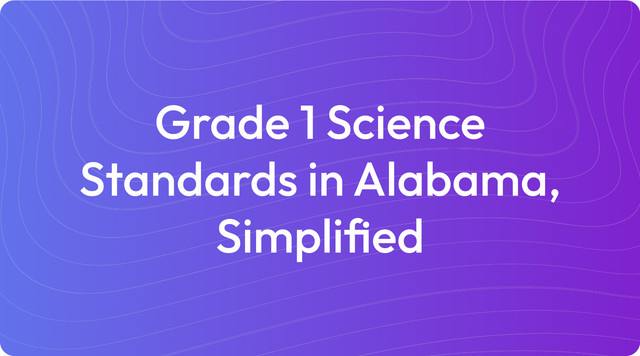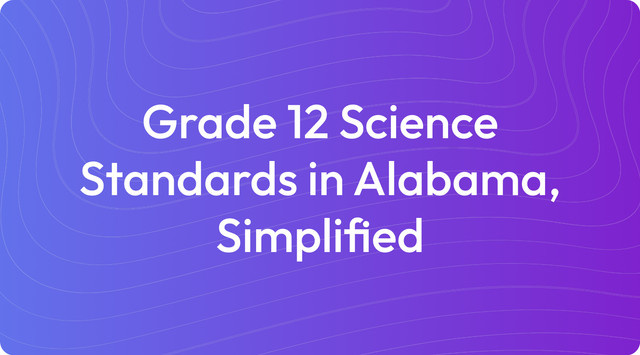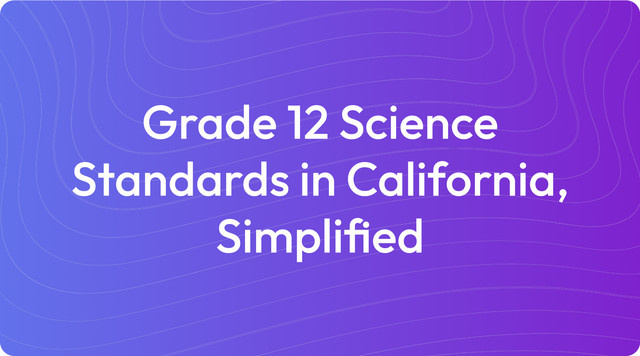Grade 9 Science Standards in Alabama, Simplified
Grade 9 science in Alabama introduces motion, forces, energy, and matter principles. For a snapshot, read more on TeachShare!

We understand that working with education standards can feel complex. They form the foundation of curriculum planning and instruction, but interpreting them isn't always straightforward. Our goal is to provide tools that help you connect these standards to practical classroom activities.
Education standards are learning goals that outline what students should know and be able to do at each grade level. For teachers, they provide a clear framework for instruction without dictating specific teaching methods. For instance, Alabama's Grade 9 Science Standards require students to develop models of atoms, but you decide on the best activity to achieve that, whether it's creating physical models or using digital tools.
What Are Grade 9 Science Standards in Alabama?
The Grade 9 Science Standards in Alabama, based on the Alabama Course of Study: Science, establish a strong foundation in Physical Science and Biology. These standards are designed to prepare students for future science courses by focusing on scientific inquiry and real-world problem-solving.
Key Areas of Grade 9 Science Standards in Alabama
1. Physical Science (PS): Matter and Energy
- Standard 1: Develop models to describe the structure of atoms, including protons, neutrons, and electrons
- Standard 2: Use the periodic table to predict properties of elements based on their atomic structure
- Standard 3: Analyze and interpret data to provide evidence for the law of conservation of mass during chemical reactions
- Standard 4: Construct explanations for energy transfer in systems, including thermal, chemical, and mechanical energy
2. Biology (LS): Cells and Organisms
- Standard 5: Analyze and interpret data to describe how cellular processes like photosynthesis and cellular respiration provide energy for life
- Standard 6: Use models to explain the structure and function of DNA and its role in protein synthesis
- Standard 7: Investigate how genetic variation and environmental factors contribute to natural selection and evolution
3. Ecosystems and Environmental Science
- Standard 8: Develop models to describe the cycling of matter (e.g., carbon, nitrogen, water) and the flow of energy in ecosystems
- Standard 9: Design and evaluate solutions for minimizing human impact on natural resources and ecosystems
4. Engineering, Technology, and Applications of Science (ETS): Problem-Solving
- Standard 10: Apply scientific principles to design and test devices that optimize energy use or minimize environmental impact
Key Learning Goals for Grade 9 Science in Alabama
The standards are built around several key learning goals for students:
- Model and Explain: Students use models to explore atoms, DNA, photosynthesis, and ecosystems.
- Analyze Data: Students collect and interpret data related to chemical reactions, cellular processes, and environmental changes.
- Problem-Solving: Students design solutions to real-world problems, such as energy conservation or reducing pollution.
The framework for these standards is guided by resources from the Alabama State Department of Education and aligns with national topic arrangements.
Key Tested Standards
In Alabama, the Grade 9 Science Standards focus on building a strong foundation in Physical Science and Biology. Assessments are designed to measure a student's ability to analyze data, construct models, and apply their knowledge to solve problems related to matter, energy, ecosystems, and genetics. Below are the key tested standards:
Key Tested Standards for Grade 9 Science in Alabama
1. Physical Science (PS): Matter and Energy
- Standard 1: Develop models to describe the structure of atoms, including protons, neutrons, and electrons
Why It’s Key: A solid grasp of atomic structure is the first step for students to understand chemistry and how matter behaves. - Standard 2: Use the periodic table to predict properties of elements based on their atomic structure
Why It’s Key: This standard helps students use the periodic table as a predictive tool, which is fundamental for understanding chemical reactions and properties. - Standard 3: Analyze and interpret data to provide evidence for the law of conservation of mass during chemical reactions
Why It’s Key: This concept is crucial for grasping chemical equations, as it shows students that matter is not created or destroyed in reactions. - Standard 4: Construct explanations for energy transfer in systems, including thermal, chemical, and mechanical energy
Why It’s Key: By understanding energy transfer, students can connect classroom concepts to real-world applications, from engines to biological processes.
2. Biology (LS): Cells and Genetics
- Standard 5: Analyze and interpret data to describe how cellular processes like photosynthesis and cellular respiration provide energy for life
Why It’s Key: This connects the microscopic world of cells to the macroscopic world of ecosystems, showing how all life depends on energy. - Standard 6: Use models to explain the structure and function of DNA and its role in protein synthesis
Why It’s Key: This standard addresses the blueprint of life, which is central to understanding genetics, heredity, and modern biology. - Standard 7: Investigate how genetic variation and environmental factors contribute to natural selection and evolution
Why It’s Key: Here, students connect the dots between genetic traits and the broader concept of evolution through natural selection.
3. Ecosystems and Environmental Science
- Standard 8: Develop models to describe the cycling of matter (e.g., carbon, nitrogen, water) and the flow of energy in ecosystems
Why It’s Key: This provides a framework for understanding how ecosystems function and remain stable, a key part of environmental science. - Standard 9: Design and evaluate solutions for minimizing human impact on natural resources and ecosystems
Why It’s Key: This encourages students to think like scientists and engineers to tackle pressing environmental issues.
4. Engineering, Technology, and Applications of Science (ETS): Problem-Solving
- Standard 10: Apply scientific principles to design and test devices that optimize energy use or minimize environmental impact
Why It’s Key: This standard bridges science and engineering, challenging students to create practical solutions for sustainability and energy conservation.
The standards and learning goals outlined here are based on information from the Alabama State Department of Education and the topic arrangements from the Next Generation Science Standards.
Example Learning Objectives for Unit Planning
Learning objectives break down broad standards into clear, measurable goals for your students, acting as a roadmap for lesson planning and assessment. To give you a practical idea, we've outlined some examples for two Grade 9 Science standards. These objectives are written in student-friendly language and align with the Alabama Course of Study: Science.
Standard 6: DNA and Protein Synthesis
Here are some sample learning objectives:
- I can explain the structure of DNA, including its double helix shape and the role of base pairs.
- I can describe how DNA provides instructions for making proteins through transcription and translation.
- I can create a model to show how DNA is copied during replication.
- I can explain how changes in DNA (mutations) can impact the proteins produced.
Standard 3: Law of Conservation of Mass
Here are some sample learning objectives:
- I can explain the law of conservation of mass and how matter is not created or destroyed during a reaction.
- I can measure the mass of reactants and products during a chemical reaction to show that mass is conserved.
- I can use balanced chemical equations to demonstrate that mass is conserved in a reaction.
- I can interpret data (e.g., tables, graphs) to show how the mass of substances stays constant before and after a reaction.
Key Changes & Updates
The latest updates to the Grade 9 Science Standards, based on the 2015 Alabama Course of Study, shift the focus toward more hands-on, inquiry-based learning. The curriculum now encourages you to guide students through investigations, model-building, and experiments, such as demonstrating the law of conservation of mass or constructing DNA models. This approach is designed to make science more tangible and relevant by connecting concepts directly to real-world applications, from exploring solutions for environmental challenges to understanding how energy transfer works in everyday systems.
These changes also place a greater emphasis on developing critical thinking and cross-disciplinary skills. Students are now expected to use math to analyze data and literacy skills to construct evidence-based arguments. There is a strong focus on collecting and interpreting data to identify patterns and draw conclusions, particularly in areas like cellular respiration and photosynthesis. The standards also provide for a deeper exploration of genetics, evolution, and atomic structure, building a solid foundation that prepares students for advanced STEM coursework and future careers.
Create with TeachShare
We know that translating these standards into effective classroom materials takes time and creativity. Our goal is to support you in this work by making it easier to develop lessons that meet Alabama's specific requirements. With our tools, you can focus more on teaching and less on the administrative side of planning. Start creating standards-aligned instructional resources with TeachShare now.
Frequently Asked Questions
What are the main topics covered in Grade 9 Science in Alabama?
Grade 9 science in Alabama establishes a strong foundation in physical science, biology, and engineering. Here are the core areas of focus:
- Matter and Energy: Students explore atomic structure, the periodic table, the conservation of mass in chemical reactions, and how energy is transferred in different systems.
- Cellular Processes and Genetics: This includes lessons on photosynthesis, cellular respiration, DNA structure, protein synthesis, and the principles of natural selection and evolution.
- Ecosystems and Environmental Science: The curriculum covers the cycling of matter, the flow of energy, and the impact of human activities on ecosystems and natural resources.
- Engineering Design: Students get practical experience designing, building, and testing devices that solve real-world problems related to topics like energy efficiency.
What is different about the Alabama science standards?
The Alabama Course of Study: Science (2015) shifts the focus toward more active and applied learning. Here are the key differences:
- Hands-On Learning: There is a greater emphasis on students actively conducting experiments, building models, and analyzing data.
- Real-World Applications: Lessons are designed to connect scientific concepts to everyday problems, such as conserving resources or understanding energy.
- Engineering Integration: Students are asked to design, test, and improve solutions to practical challenges, from pollution to renewable energy.
- Critical Thinking: The standards push students to move beyond memorization to analyze data, identify patterns, and build explanations based on evidence.
What are some examples of activities aligned with the standards?
To help you bring these standards into your classroom, here are a few activity ideas that align with the curriculum:
- Atomic Structure: Have students create 3D models of atoms that show the placement of protons, neutrons, and electrons.
- Conservation of Mass: Students can perform simple experiments, like combining baking soda and vinegar, and measure the mass before and after the reaction to see the principle in action.
- Photosynthesis: An experiment where students grow plants in different light conditions is a great way to observe how light affects photosynthesis.
- DNA Models: Building physical models of DNA can help students visualize and understand the complex processes of transcription and translation.
How are students assessed in Grade 9 Science?
Assessment methods are designed to measure understanding in practical, authentic ways. You can evaluate student learning through the following approaches:
- Investigations: Observing students as they conduct experiments on topics like chemical reactions, photosynthesis, or population dynamics.
- Models and Projects: Evaluating student-made models of atoms, DNA, or energy systems to check for comprehension.
- Data Analysis: Asking students to interpret graphs or tables to analyze concepts like energy transfer or genetic variation.
- Explanations: Requiring students to construct well-reasoned, evidence-based explanations to communicate their findings from an activity or experiment.
Why is engineering included in Grade 9 Science?
Including engineering in the science curriculum is a deliberate choice to help students connect concepts to practice. It is included for these reasons:
- It teaches students how to apply scientific ideas to solve practical, real-world problems.
- It helps develop creativity and critical thinking skills as students design, test, and refine their own solutions.
- It clearly shows the relationship between science, technology, and innovation, particularly for addressing modern challenges like energy efficiency and environmental sustainability.
Answer







